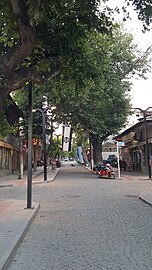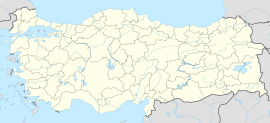Mürefte (formerly Myriophyton; Greek: Μυριόφυτον) is a neighbourhood of the municipality and district of Şarköy, Tekirdağ Province, Turkey.[1] Its population is 2,412 (2022).[2] Before the 2013 reorganisation, it was a town (belde).[3][4] It is on the Sea of Marmara about 51 km southwest of Tekirdağ.
Mürefte | |
|---|---|
 Street of Mürefte | |
| Coordinates: 40°40′N 27°15′E / 40.667°N 27.250°E | |
| Country | Turkey |
| Province | Tekirdağ |
| District | Şarköy |
| Population (2022) | 2,412 |
| Time zone | UTC+3 (TRT) |
The early history of this town is not known. It is first mentioned in connection with an earthquake which destroyed it in the year 1063.[5] It was visited by John Cantacuzene about 1350.[6] After the population exchange some Megleno-Romanian families were settled.
Ecclesiastical history
editThe original diocese was in Thracia Prima, a suffragan of Heraclea Perinthos.
A diocese of Peristatis (modern Şarköy) was established by 1170.[7] The see was later transferred to Myriophyton, and renamed Peristasis and Myriophyton, mentioned first in a Notitia episcopatuum of the end of the fifteenth century.[8] In the sixteenth century Myriophytum displaced Peristasis, and the diocese took the name of Myriophyturn and Peristasis.[9]
According to the Ottoman population statistics of 1914, the kaza of Mürefte had a population of 16,876 consisting of 14,146 Greeks (83.84%) and 2,730 Muslims (16.18%).[10]
The Greek Orthodox diocese became in January 1909 an autocephalous metropolitan see, the Metropolitanate of Myriophyton and Peristasis. The Orthodox population of the metropolitanate was evacuated in October 1922, just before the Greco-Turkish population exchange, leaving no Orthodox population since then, but the church continues to appoint titular metropolitans to the see.[11]
The last Roman Catholic holder of the titular see of Myriophytos or Miriofido died in 1932, and the see has been suppressed.[12]
Agriculture
editThe coastline between Tekirdağ and Şarköy, particularly Mürefte, are notable centers for viticulture and winemaking. A well-known wine producer, "Kutman", is located in the village, and maintains a wine museum also.[13][14]
Notable people
edit- Aristotelis Kourtidis (1858 – 1928), Greek educator and writer.
- Vasilis Logothetidis (1897 - 1960), Greek actor.
References
edit- ^ Mahalle, Turkey Civil Administration Departments Inventory. Retrieved 19 September 2023.
- ^ "Address-based population registration system (ADNKS) results dated 31 December 2022, Favorite Reports" (XLS). TÜİK. Retrieved 19 September 2023.
- ^ "Law No. 6360". Official Gazette (in Turkish). 6 December 2012.
- ^ "Classification tables of municipalities and their affiliates and local administrative units" (DOC). Official Gazette (in Turkish). 12 September 2010.
- ^ Muralt, "Essai de chronologie byzantine", II, 8.
- ^ Hist., III, 76.
- ^ Parthey, "Hieroclis Synecdemus", 103.
- ^ Heinrich Gelzer, Ungedruckte ... Texte der Notitiae episcopatuum, 633.
- ^ Le Quien, Oriens christianus, I, 1151.
- ^ Kemal Karpat (1985), Ottoman Population, 1830-1914, Demographic and Social Characteristics, The University of Wisconsin Press, p. 170–171
- ^ Kiminas 2009, pp. 61.
- ^ "Myriophytos". Catholic-Hierarchy.org. David M. Cheney. Retrieved 21 January 2015.
- ^ Akyol, Cahit (2005-06-04). "İşte Türkiye'nin şaraplık üzüm haritası". Hürriyet (in Turkish). Retrieved 2015-07-28.
- ^ "Fwyzi Kutman Mürefte Şarap Müzesi" (in Turkish). e-yasamrehberi.com. Retrieved 2015-07-28.
Sources
edit- This article incorporates text from a publication now in the public domain: Herbermann, Charles, ed. (1913). "Myriophytum". Catholic Encyclopedia. New York: Robert Appleton Company. The entry cites:
- Drakos, Thrakika (in Greek, Athens, 1892), 72–93.
- Kiminas, Demetrius (2009). The Ecumenical Patriarchate: A History of Its Metropolitanates with Annotated Hierarch Catalogs. Wildside Press LLC. ISBN 9781434458766.
- Külzer, Andreas (2008). Tabula Imperii Byzantini: Band 12, Ostthrakien (Eurōpē) (in German). Vienna: Österreichische Akademie der Wissenschaften. p. 540. ISBN 978-3-7001-3945-4.

